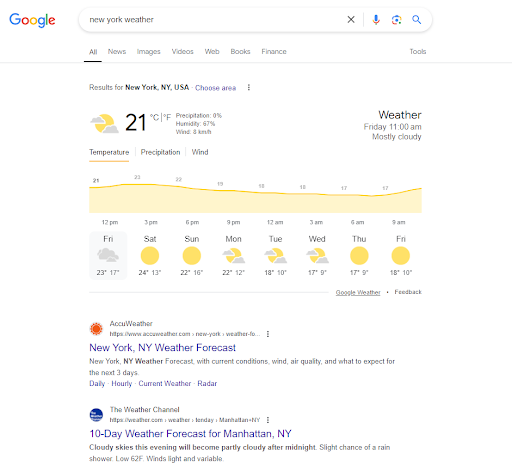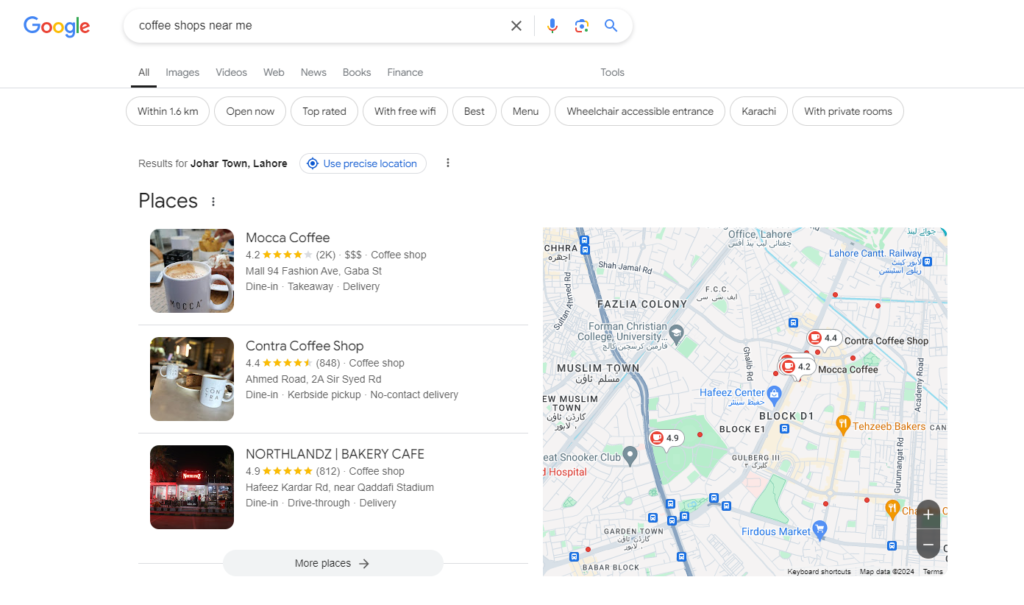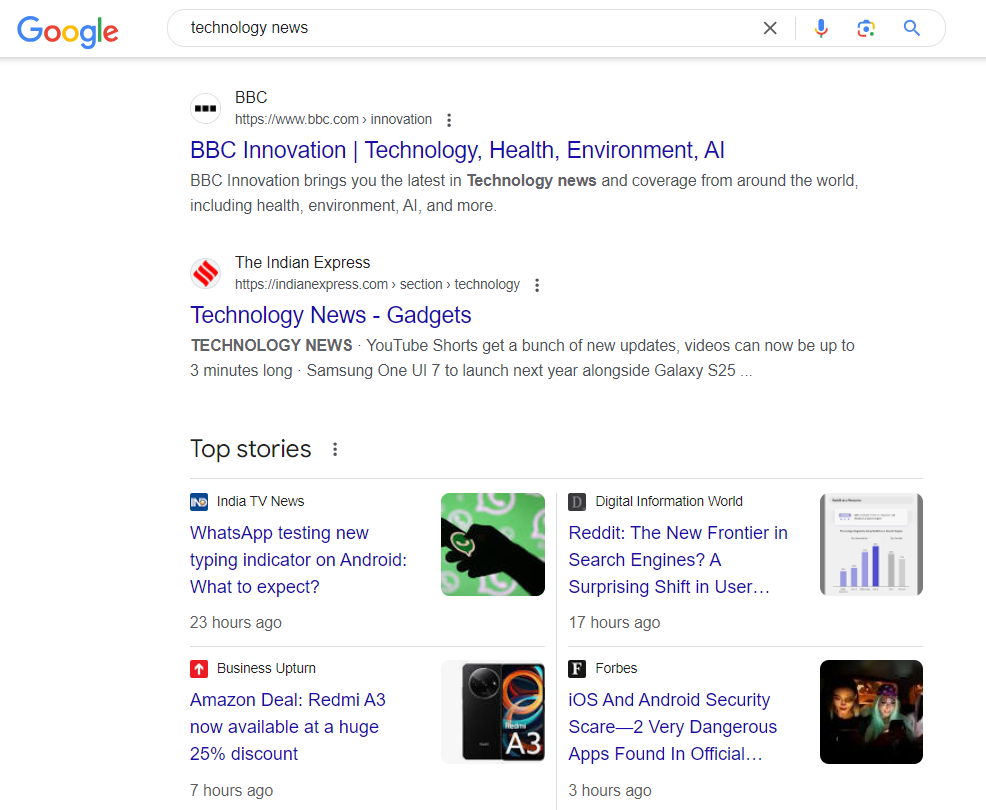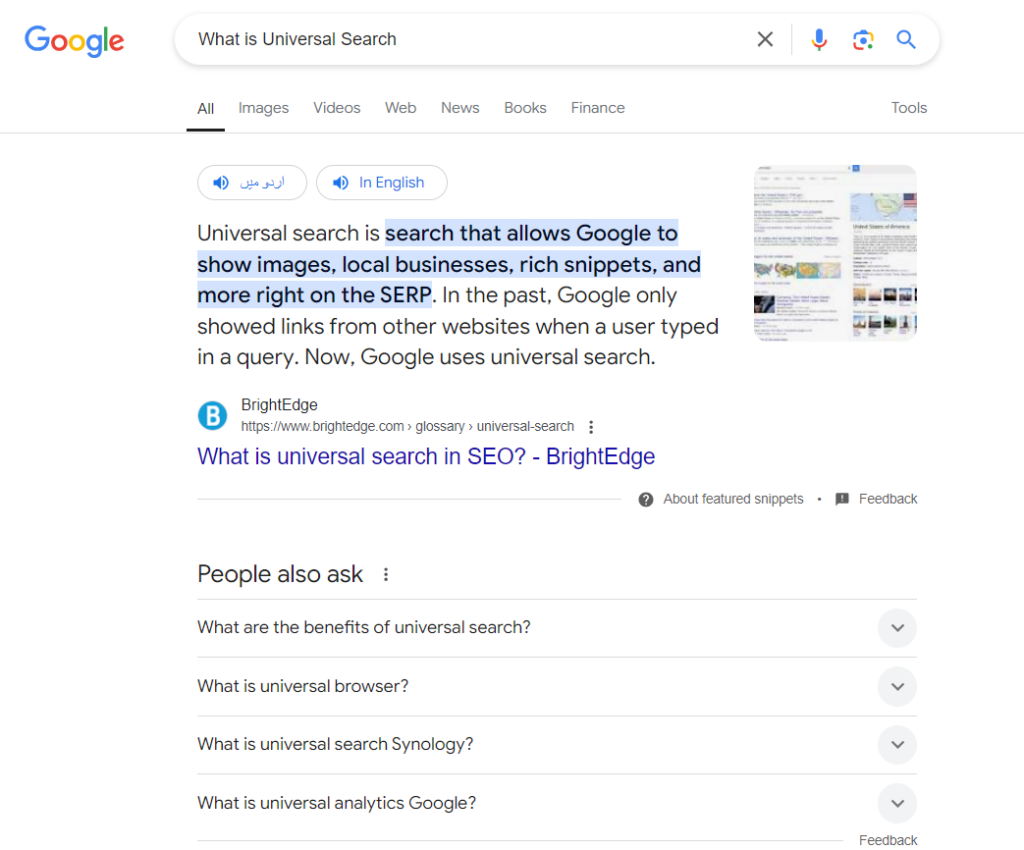In 2007, Google revolutionized search results by introducing Universal Search, a change that altered how users and marketers interacted with search engines. No longer confined to traditional “blue links,” the search engine experience became a comprehensive multimedia affair.
Now, search results provide answers in the most helpful format – whether it’s images, videos, news, or local listings.
This guide will explore how Universal Search works, why it matters, and how you can optimize your content to ensure it appears across various result types.
What Is Universal Search?
Universal Search integrates multiple media types, such as images, news articles, videos, and local business listings, into one set of results. Instead of seeing a list of ten blue links – which was once the standard – users are now presented with results that address different queries and content preferences.
For example, when searching for “New York weather,” a traditional search might have shown a weather-related article or blog post. Now, users are more likely to see a real-time weather widget, images of the current weather conditions, and links to relevant news articles.

A Brief History of Universal Search
In May 2007, Google launched a major update that transformed search functionality by expanding results beyond simple webpage links to include a variety of media content.
Over time, it evolved to integrate even more types of content, including:
- Maps and Local Listings
- Rich Snippets and Featured Snippets
- Reviews and Ratings
- Shopping Results
- FAQs
- Video carousels from platforms like YouTube
This transformation significantly improved user experience by presenting more relevant and comprehensive information.
Key Components of Universal Search
Several distinct content types regularly appear in search results. Below are the most common ones:
1. Videos
Videos are a prominent feature in search results, with platforms like YouTube (owned by Google) often dominating the video results. In fact, videos appear in a significant percentage of both mobile and desktop searches, making them a powerful component of modern search experiences.

2. Images
Image results are frequently pulled from Google Images and are particularly useful for visually focused queries. Users often see images displayed directly in the search results, providing them with quick visual information.

3. Local Listings and Maps
Local businesses are commonly featured in search results through the “Local Pack,” which displays a map alongside nearby business listings. This is especially beneficial for location-based searches, offering users essential details like addresses, hours of operation, and reviews.

4. News and Blog Posts
News articles and blog posts from authoritative websites are regularly blended into search results, especially for queries related to current events or industry trends. These results provide timely information, making them vital for sectors like technology, healthcare, and finance.

5. Featured Snippets
Featured snippets are brief, direct answers to user queries that appear at the very top of the SERP. They are highly valuable because they often rank above traditional organic results, providing users with immediate answers without requiring a click-through.

The Impact of Universal Search
The integration of diverse content formats offers significant benefits for both users and marketers by increasing visibility and delivering more relevant results. This highlights the need for businesses to optimize their content for rich media formats—such as featured snippets, videos, and local listings—to capture attention directly within search results.
As more businesses adopt AI-powered solutions like GPT-4, these formats will only become more crucial in engaging users without relying on traditional click-throughs.
The Benefits for Users
Universal Search enhances the user experience by delivering faster, more personalized results that align with intent. It provides diverse content formats while saving time by displaying the most relevant information at the top, often without requiring clicks.
This creates a seamless, holistic search journey, allowing users to quickly find answers, compare products, or explore local businesses, all within a single search results page.
The Benefits for Marketers
For digital marketers, the integration of various content formats provides several new ways to showcase content. If your SEO strategy only focuses on ranking text-based content like blog posts and articles, you’re missing out on a big chunk of potential traffic. Marketers who optimize for multiple formats have an edge over their competition.
Why Universal Search Matters for SEO
It is a game-changer for SEO because it expands the types of content that can rank in the search results. It’s no longer enough to just focus on ranking a webpage—videos, images, and even news articles now play a crucial role in visibility.
With Universal Search, Google pulls content from its verticals, such as YouTube (which often dominates video search results) and Google Maps (for local business listings). Optimizing across these multiple formats ensures better exposure and increases the likelihood of appearing in valuable SERP positions.
How to Optimize for Universal Search
Here’s a comprehensive guide to optimizing your content for better visibility across multiple content formats:
1. Keyword Research
Begin by identifying which types of content are currently ranking for your target keywords. Tools like Ahrefs and SEMrush can help you determine whether video, images, or local listings appear for specific queries.
2. Diversify Your Content
Once you’ve identified the formats that rank well, diversify your content strategy. If videos are prominent, start producing and optimizing video content. If images rank, ensure your site has relevant, optimized visuals.
3. Utilize Schema Markup
Schema markup helps search engines understand and categorize your content more effectively. By adding structured data, you increase the likelihood of appearing in rich results. This enhances visibility and makes your content more relevant to different search result types.
4. Improve Page Load Speed
Page load speed affects how well your content ranks in all formats, especially for images and videos. Compress media files, use a content delivery network (CDN), and leverage browser caching to boost load times.
5. Monitor Performance
Use tools like Google Search Console to monitor how your content is performing across different formats. Track metrics like impressions, click-through rates, and overall rankings.
The Future of Universal Search
As Google continues to evolve, Universal Search has remarkable worth. The search landscape is becoming increasingly dynamic and personalized, catering to individual users’ specific needs and behaviors. Here are some trends and predictions for the future of search:
1. Integration of New Content Formats
Google is likely to incorporate more diverse content types into search results, such as:
- Podcasts: As audio content grows in popularity, Google may integrate podcasts into search results, offering snippets or direct links to relevant episodes.
- Interactive Elements: Quizzes, polls, and other interactive content could appear in search results, providing a more engaging user experience.
- Augmented Reality (AR): As AR advances, Google might include AR experiences for searches related to shopping, education, and travel.
2. Increased Emphasis on Visual Search
Visual search capabilities are improving, allowing users to search using images rather than text. This trend will likely continue with features such as:
- Image Recognition: Enhanced algorithms that understand and categorize images more effectively.
- Visual Shopping: Users may upload photos of products they’re interested in, and search results will return shopping options, prices, and reviews in real-time, simplifying the purchasing process.
3. Real-Time Data Integration
Google will likely integrate more real-time data into search results, enhancing the immediacy and relevance of the information provided. Examples include:
- Live Events: Real-time updates for sports scores, stock prices, and news events.
- Dynamic Content: Continuously updated content like live weather reports, traffic updates, and social media trends.
4. Expanded Rich Snippets and Knowledge Graphs
Rich snippets and the Knowledge Graph will become more comprehensive, offering detailed answers directly in the search results. This means:
- Extended Information Panels: Providing more in-depth information within the SERP without requiring users to click through to another page.
- Interlinked Data: Connecting various pieces of information to present a holistic view of a topic.
5. Machine Learning and AI Advancements
Machine learning and AI will help enhance how different media types are integrated and displayed. These advancements will improve:
- Content Understanding: AI will become better at understanding and categorizing various types of content and user intent.
- Search Efficiency: AI will help serve faster, more accurate results by selecting and blending content types based on individual user needs.
- Predictive Search: AI will anticipate user queries, suggesting relevant media types before the search is completed, based on patterns, context, and past behavior.
Staying Ahead in the Evolving World of Search
Universal Search has dramatically transformed how users interact with search results, and as this feature continues to develop, staying ahead of the curve is crucial. While optimizing your content across multiple formats is essential, the true key to long-term success lies in adaptability.
As search behaviors change, Google will likely integrate more unique content types. Forward-thinking marketers should start exploring these emerging formats to stay competitive.
By preparing for future trends and consistently monitoring your performance across different content formats, you can ensure your content strategy remains effective and future-proof. The search ecosystem is ever-changing, and those who innovate will lead the way.
References:
- https://www.prlog.org/13043710-by-2025-65-of-google-searches-are-expected-to-end-with-zero-clicks.html

We empower people to succeed through information and essential services. Do you need help with something? Contact Us.
Want a heads-up once a week whenever a new article drops?







